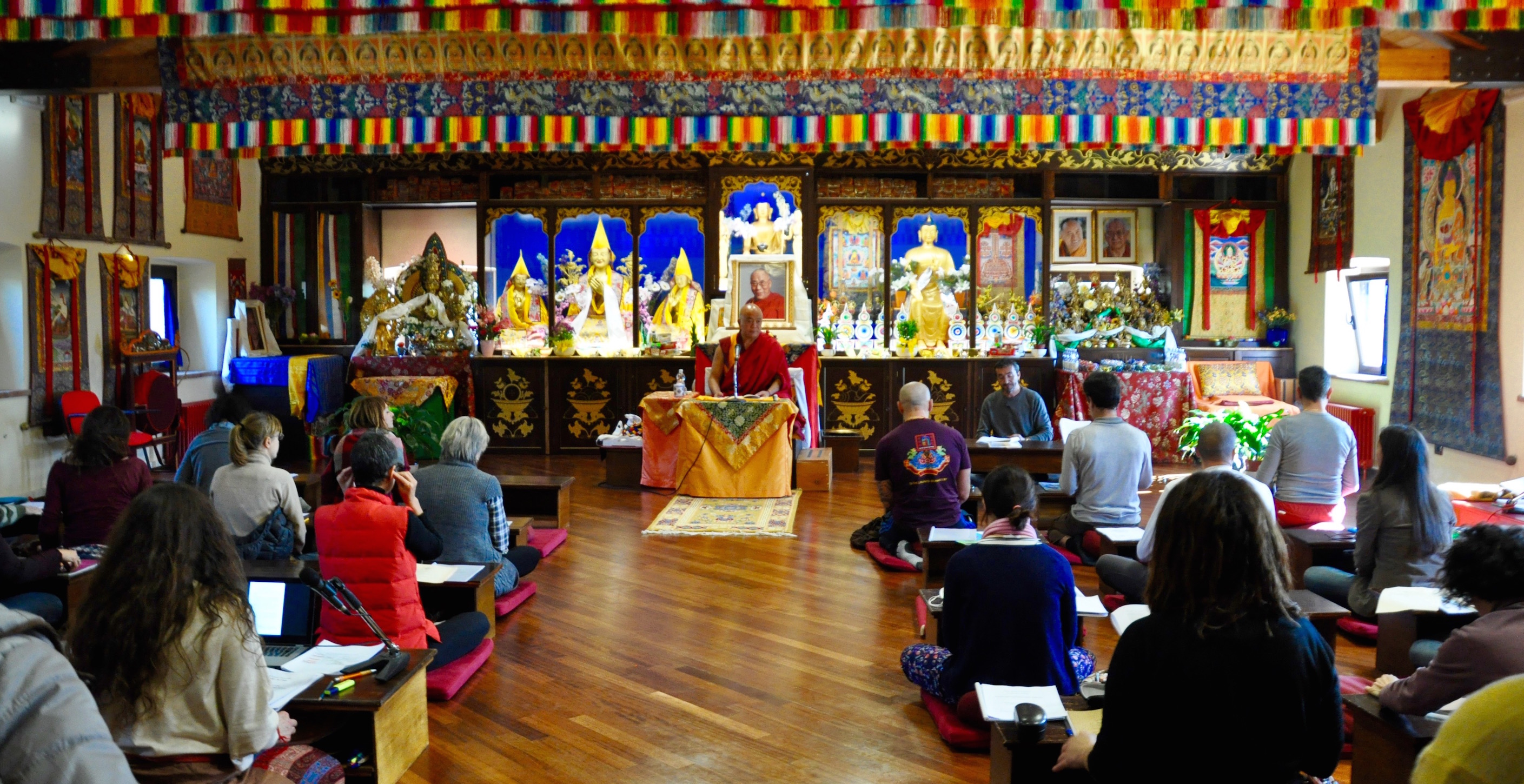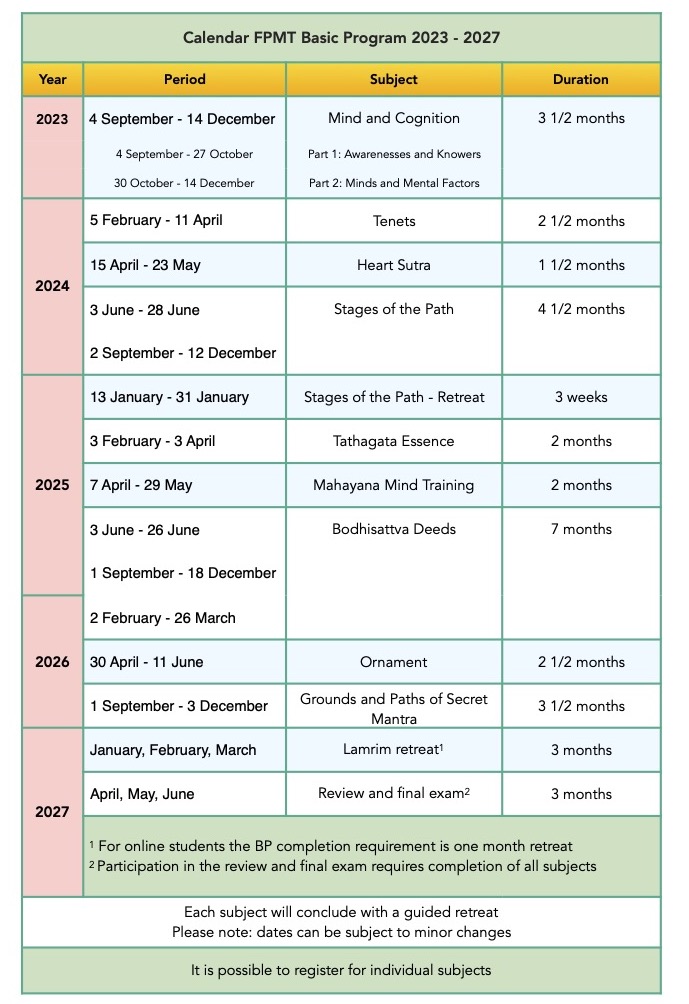FPMT Basic Program 2023 – 2027
Watch the presentation video
ILTK’s fifth FPMT Basic Program starts September 2023 and finishes June 2027!
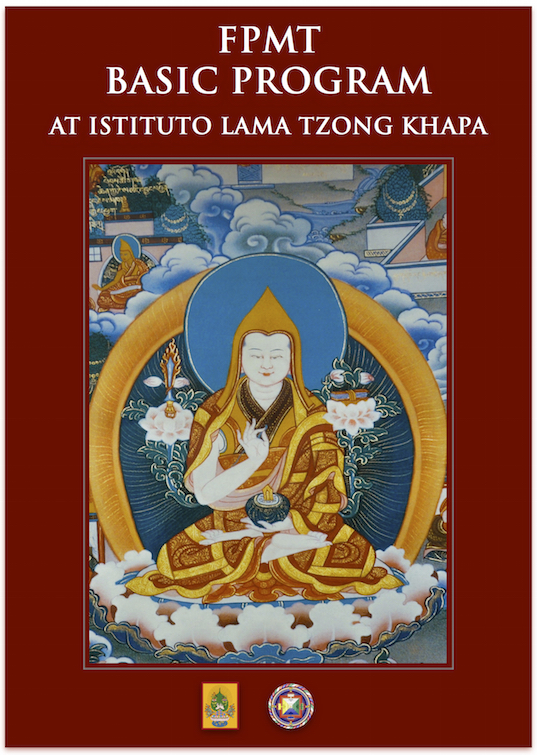
The FPMT Basic Program is intended for students who wish to progress beyond foundational level courses and are ready to commit themselves to in-depth study and practice.
The Institute offers the program both residentially and online.
The program is composed of nine subjects. Daily teachings are combined with review classes and discussion groups, meditation practice, reflection on one’s ethical behavior, and community service. These are integral components of the program.
Ven. Geshe Tenzin Tenphel
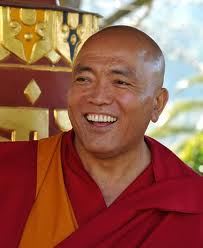
Geshe Tenzin Tenphel was born into a nomadic agricultural family in Domo, Tibet, near the Indian province of Sikkim. In 1959, with the Chinese invasion of Tibet, Geshe Tenphel’s family fled to Sikkim and later to South India.
Geshe Tenphel became a monk when he was nine years old and continued studying at the local secular school while memorizing Buddhist scriptures during his holidays.
Geshe-la entered Sera Je monastery at the age of 17, where he completed 21 years of monastic scholastic education, graduating with honors in 1994 with a Lharam Geshe degree, the highest Tibetan Buddhist doctorate conferred in the Gelug tradition. Geshe Tenphel then studied tantra for one year at Gyu To Tantric College.
Since January 1998, Geshe Tenphel has been resident teacher at Lama Tzong Khapa Institute, where he teaches numerous courses including the Basic Program. Geshe-la is much appreciated for his teaching style being humorous, practical and uplifting and he specially links his teachings to daily life. He gives direct instructions on how to practice and transform our minds.
The teacher for the last subject: Grounds and Paths of Secret Mantra
Geshe Jampa Gelek
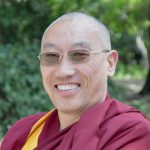
Geshe Jampa Gelek was born in 1966 in the eastern region of Kham, Tibet. He decided to become a monk early in life. At the age of 16, due to the Chinese invasion, he left Lhasa and went to India. He studied at Sera Je Monastic University, where, at a very early age of 19, he became a fully ordained monk. His Holiness the Dalai Lama and Choden Rinpoche are his main teachers. In 1999, being awarded the title of Lharampa Geshe, he continued his education with the study of tantra, qualifying him to give empowerments and commentaries. Since 2012, together with Geshe Tenzin Tenphel, he is resident teacher at Lama Tzong Khapa Institute.
Geshe Gelek teaches the FPMT Masters Program in a very dedicated and enthusiastic manner, sharing his amazing vast and profound knowledge with us.
The FPMT Basic Program at ILTK presents the nine subjects of the core curriculum:
- Mind and Cognition: the way the mind knows phenomena and the mental factors that constitute the basis of our daily experience
- Tenets: the philosophical systems, or tenets, of the four main schools of ancient Buddhist thought
- Heart Sutra: emptiness and the phenomena qualified by it
- Stages of the Path: Middle Length Lamrim: the stages of the path to enlightenment of beings of low, middling, and great capacity
- The Tathagata Essence: the buddha lineage or tathagata essence that exists within every sentient being
- Mahayana Mind Training: Wheel of Sharp Weapons: the law of actions and results, or karma, and the states of mind that shape our future experiences
- Engaging in the Bodhisattva Deeds: the six perfections—generosity, morality, patience, joyous effort, concentration, and wisdom—and how to practice them in everyday life
- Ornament for Clear Realization: the 173 aspects of the omniscient mind and the practices that enable to achieve them
- Grounds and Paths of Secret Mantra: the four classes of tantra with emphasis on the generation and completion stages of highest yoga tantra
____________________________________________________
The FPMT Basic Program subjects and texts
1. Mind and Cognition
“All human accomplishment is preceded by valid cognition.”
Dharmakirti
Mind and Cognition begins with the study of mind, both in its valid and distorted forms. In addition a number of important themes are introduced, including the relationship between subject and object, supramundane (yogic) knowing and the connection between thought and reality.
An introduction to Buddhist psychology forms the latter part of the teaching, where the various positive and negative emotions as well as the cognitive states relevant to practice of a liberative path are identified and defined.
Text part 1: Yongdzin Purbuchok, Explanation of the Presentation of Objects and Object-Possessors as well as Mind and Cognition
Text part 2: Kachen Yeshe Gyaltsen, Clear Exposition of the Modes of Minds and Mental Factors: a Necklace for those of Clear Mind
2. Tenets
“My doctrine has two modes: advice and tenets. To children I speak advice, and to yogis, tenets.”
Lankavatarasutra
Based on the idea that the Buddha taught different things to different people in line with their capacities, Tibetan scholars systemized the numerous trends in Indian Buddhist thought and taught the four schools of tenets as a means to approach the most profound philosophical teachings via more accessible levels. The text that is the basis for study of this subject gives a brief overview of the assertions on minds, objects, selflessness and the nature of attainment within each of the schools, culminating in the tenets of the most highly esteemed school, the Madhyamaka.
Text: Jetsun Chokyi Gyaltsen, Presentation of Tenets
3. Heart Sutra
“Form is empty, emptiness is form; form is not other than emptiness, emptiness is not other than form.”
Shakyamuni Buddha
Among the most famous of all the Buddhist scriptures, the Heart Sutra reveals the truth of emptiness through a short exchange between two of the Buddha’s most illustrious disciples, Avalokiteshvara and Shariputra. Traditional commentary expands on the cryptic style of the sutra to clarify the exact nature of the wisdom realizing emptiness and the ‘method’ practices that are its essential complement, relating these two aspects of practice to the five levels on the path to enlightenment. The brevity and profound nature of the Heart Sutra have made its recitation popular as an effective means for dispelling obstacles to spiritual endeavour.
Text: Shakyamuni Buddha, The Heart of Wisdom Sutra
Commentary: Tendar Lharampa, Jewel Light Illuminating the Meaning
4. Stages of the Path
“With study comes understanding; but this must be put to use. It is therefore vital to put as much as one can of what one has studied into practice.”
Lama Tsongkhapa
The celebrated system of teachings known as the Stages of the Path (Lamrim) represents a synthesis of the entire path to enlightenment. Presented in a clear and concise form, these teachings are easy to understand and apply in meditation. Instruction begins with the preliminary practices, and then progresses through the essential practices of the ‘beings of the three scopes’, including correct guru devotion, renunciation, the altruistic wish for enlightenment and the view of the middle way. As a foundation and context for Buddhist practice, this subject is a key element of the FPMT Basic Program.
Text: Je Tsongkhapa, Midde Length Exposition of the Stages of the Path
5.Tathagata Essence
“I bow to the one who, with no beginning, middle or end, has a serene stillness and is clear-minded and fully evolved, who became clear from his own aspects and once clear, shows fearless, constant paths of the mind to bring realization to those with no realization.”
Maitreya
One of the major texts studied in all traditions of Tibetan Buddhism, Maitreya’s Sublime Continuum clarifies the meaning of our buddha potential, in particular the emptiness of the mind that allows evolution to a state of complete enlightenment. The first chapter of this work, which explains four related ‘vajra’ subjects – Buddha, Dharma, Sangha and the buddha potential or tathagata essence – will be the focus of this teaching.
Text: Maitreya, Sublime Continuum of the Mahayana
Commentary: Gyaltsab Je, Commentary on (Maitreya’s) ‘Sublime Continuum of the Mahayana’
6. Mahayana Mind Training
“And thus bodhisattvas are likened to peacocks: They live on delusions – those poisonous plants. Transforming them into the essence of practice, they thrive in the jungle of everyday life. Whatever is presented they always accept, while destroying the poison of clinging desire.”
Dharmarakshita
The Mahayana path is characterized by the bodhisattva’s aspiration to become a buddha for the sake of all beings. The means to develop and enhance this extraordinary attitude are revealed in a genre of teachings, at once practical and radical, known as ‘mind training’, or ‘thought transformation’ (lojong). Dharmarakshita’s Wheel of Sharp Weapons is one of the most esteemed mind training teachings, and a powerful weapon to cut through our true enemies – the self-grasping and self-cherishing which oppose altruistic intent and prevent lasting happiness and peace.
Text: Dharmarakshita, The Wheel of Sharp Weapons
7. Engaging in the Bodhisattva Deeds
“For as long as space endures, and for as long as living beings remain, until then may I too abide, to dispel the misery of the world.”
Shantideva
The teaching on the bodhisattva’s deeds is based on Shantideva’s inspirational verses on Mahayana aspiration and practice, composed more than a thousand years ago and still widely regarded as the most authentic and complete guide for the practitioner dedicated to the enlightenment of all beings. This highest of motivations lies at the heart of his Guide to the Bodhisattva Deeds, which ranges in scope from simple, practical techniques for developing generosity and dealing with destructive emotions, up to the most refined discussion of ultimate truth. Due to its authenticity and relevance for everyday life, this classic is probably cited more often in teachings by Tibetan Buddhist masters than any other Buddhist scripture.
Text: Shantideva, Engaging in the Bodhisattva Deeds
Commentary: Dragpa Gyaltsen, Commentary to (Shantideva’s) ‘Engaging in the Bodhisattva Deeds’
8. Ornament
“That which through the knower of all leads hearers seeking pacification to peace, which through the knower of paths causes those helping migrators to achieve the aims of the world, and through the perfect possession of which the Munis set forth these varieties having all aspects, to the Mother of the Buddhas as well as the host of hearers and bodhisattvas, I pay homage.”
Maitreya
Maitreya’s Ornament for Clear Realizations is the root text for the study of the levels of realization related to enlightenment according to the Madhyamaka school. This important scripture, traditionally the basis for extensive study in the monastic curriculum, made explicit these levels which were otherwise presented in only a hidden manner in the Buddha’s Perfection of Wisdom teachings. From among the seventy topics covered by the Ornament, the eleven topics of chapter four have been selected for commentary in the FPMT Basic Program curriculum, with an emphasis on the 37 Harmonies with Enlightenment.
Text: Maitreya, Ornament for Clear Realizations
Commentary: Chokyi Gyaltsen, General Meaning of the Fourth Chapter
9. Grounds and Paths of Secret Mantra
“In brief, the buddhahood achieved over countless eons, you will attain in this birth, through the most excellent bliss, or the state of Vajradhara.”
Samputa Tantra
Grounds and Paths of Secret Mantra offers a concise overview of the structure of the tantric path, widely acclaimed in Tibet as the swiftest and most sublime means to realize buddhahood. Tantra distinguishes itself in particular through a unique combination of method and wisdom, achieved through meditation on the perfect form of a buddha as completely devoid of true existence. Presenting the paths of all four classes of tantra, while not being a guide to highest yoga tantra practice itself, this subject provides a clear overview of its complex path structure.
Book of Wisdom Publication: Principles of Buddhist Tantra, by Kirti Tsenshap Rinpoche, which includes Ngawang Palden’s: Illumination of the Tantric Tradition
Requirements for Grounds and Paths of Secret Mantra
To study Grounds and Paths of Secret Mantra, there are specific requirements pertaining to tantra:
In order to study this subject it is necessary to have taken refuge, which implies making a life-long commitment to the Buddhist spiritual path, and to have received a highest yoga tantra empowerment. A highest yoga tantra empowerment must have been received from a qualified teacher and entails taking the bodhisattva and tantra vows along with the commitment to do the Six Session Guru Yoga practice on a daily basis.
Interpreter from Tibetan to English:
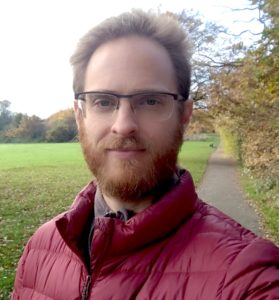 Shahar Tene was born in Israel but has lived in the UK for most of his life. He holds an MSc in Physics from the University of Reading, an MA in Philosophy from King’s College London, and did postgraduate studies at SOAS, London. Shahar has been a student and practitioner of Buddhism since 2007, starting with various courses at Tushita and Root Institute in India. In 2014 he completed the residential FPMT Basic Program at ILTK, with its Master’s in Wisdom university accreditation and three months of meditation retreat. He also completed parts of the FPMT Masters Program, and is an FPMT registered teacher. Shahar has since been focusing on Tibetan Language, graduating from the Lotsawa Rinchen Zangpo Translator Program in 2020, after which he worked as a Tibetan to English interpreter both online and at centers such as Thosamling Institute in Dharamsala, India. Returning to ILTK in 2023, Shahar will be the residential Teaching Assistant and the online Tutor forILTK’s fifth FPMT Basic Program.
Shahar Tene was born in Israel but has lived in the UK for most of his life. He holds an MSc in Physics from the University of Reading, an MA in Philosophy from King’s College London, and did postgraduate studies at SOAS, London. Shahar has been a student and practitioner of Buddhism since 2007, starting with various courses at Tushita and Root Institute in India. In 2014 he completed the residential FPMT Basic Program at ILTK, with its Master’s in Wisdom university accreditation and three months of meditation retreat. He also completed parts of the FPMT Masters Program, and is an FPMT registered teacher. Shahar has since been focusing on Tibetan Language, graduating from the Lotsawa Rinchen Zangpo Translator Program in 2020, after which he worked as a Tibetan to English interpreter both online and at centers such as Thosamling Institute in Dharamsala, India. Returning to ILTK in 2023, Shahar will be the residential Teaching Assistant and the online Tutor forILTK’s fifth FPMT Basic Program.
English residential BP teaching assistant and Online tutor
Shahar Tene
 Shahar was born in Israel but has lived in the UK for most of his life. He holds an MSc in Physics from the University of Reading, an MA in Philosophy from King’s College London, and did postgraduate studies at SOAS, London. Shahar has been a student and practitioner of Buddhism since 2007, starting with various courses at Tushita and Root Institute in India. In 2014 he completed the residential FPMT Basic Program at ILTK, with its Master’s in Wisdom university accreditation and three months of meditation retreat. He also completed parts of the FPMT Masters Program, and is an FPMT registered teacher. Shahar has since been focusing on Tibetan Language, graduating from the Lotsawa Rinchen Zangpo Translator Program in 2020, after which he worked as a Tibetan to English interpreter both online and at centers such as Thosamling Institute in Dharamsala, India. Returning to ILTK in 2023, Shahar will be the residential Teaching Assistant and the online Tutor forILTK’s fifth FPMT Basic Program.
Shahar was born in Israel but has lived in the UK for most of his life. He holds an MSc in Physics from the University of Reading, an MA in Philosophy from King’s College London, and did postgraduate studies at SOAS, London. Shahar has been a student and practitioner of Buddhism since 2007, starting with various courses at Tushita and Root Institute in India. In 2014 he completed the residential FPMT Basic Program at ILTK, with its Master’s in Wisdom university accreditation and three months of meditation retreat. He also completed parts of the FPMT Masters Program, and is an FPMT registered teacher. Shahar has since been focusing on Tibetan Language, graduating from the Lotsawa Rinchen Zangpo Translator Program in 2020, after which he worked as a Tibetan to English interpreter both online and at centers such as Thosamling Institute in Dharamsala, India. Returning to ILTK in 2023, Shahar will be the residential Teaching Assistant and the online Tutor forILTK’s fifth FPMT Basic Program.

“Here we spend time studying the meaning of the words and then we try to put them into meditation and practice. In this way, we can develop concentration and wisdom and tame our minds; combining meditation and study, the mind is tamed and becomes better. In this way, we try to eliminate afflictive emotions so that the mind becomes more quiet, more relaxed and more happy.”
Geshe Jampa Gyatso
In order to develop a basis for meditation, Buddha taught the importance of listening to the teachings and contemplating them as a way to attain a clear comprehension of the path to enlightenment. According to a Tibetan saying: “The one who meditates without having listened to the teachings is comparable to the one who tries to climb a snow mountain without using their hands”.
Each of these phases, listening, studying and contemplating, and meditating, leads respectively to the wisdom that arises from listening, the wisdom that arises from contemplation and the wisdom that arises from meditation.
To this end the FPMT Basic Program was especially designed to offer a balanced approach that combines the academic training and meditation practice which characterize the Gelugpa tradition of Tibetan Buddhism, and to gain practical and immediate benefit from the study and comprehension of the philosophical subjects. Online FPMT Basic Program participants as well are suggested to plan regular meditation sessions throughout their studies. Topics of meditation related to the subject that is being studied will be proposed by the teaching assistant and online tutor.
During the FPMT Basic Program group meditation retreats will be organized to encourage the integration of the teachings into one’s practice, and online students are strongly encouraged to take part in these retreats if at all possible, or to conduct such retreats at home.
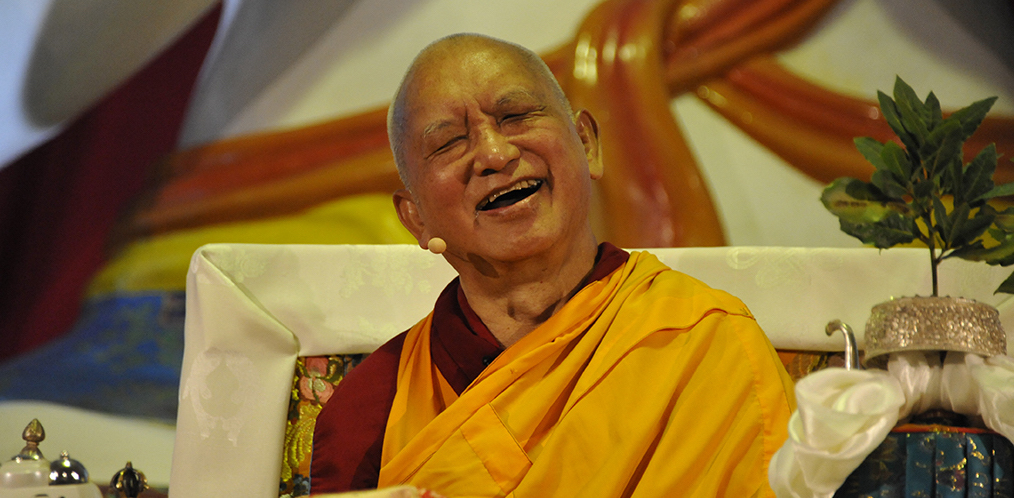
Learning Dharma means less ignorance, more wisdom. It means more light in your life, in your mind, no darkness. That means you have more freedom in your life to achieve liberation from samsara, great enlightenment. The more you understand Dharma means you can educate more, benefit others more, give more light to others, you can cause them to have deeper and clearer understanding of the Dharma. The benefits of preserving Dharma can’t be explained by all the omniscient ones, the Buddhas, even for eons. The more you hear Dharma, it plants more seed of liberation and enlightenment. It makes it so much easier for future lives, easier to achieve liberation and enlightenment. You have a good qualified teacher. Therefore take the opportunity to learn Dharma. Don’t waste your precious human life.
For more information about the FPMT Basic Program please contact:
Segreteria Didattica
segreteriadidattica@iltk.it
Office telephone: 0039 050-685009
Thank you for your interest.
